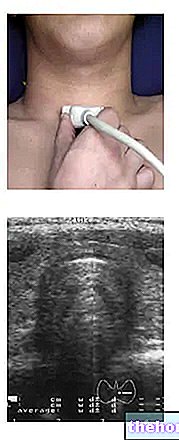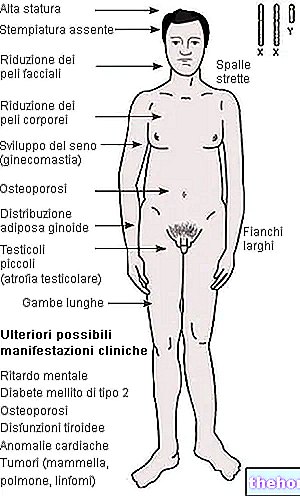Generality
Therapy with iodine 131 (131I) has traditionally been reserved for patients with hyperthyroidism, a condition in which the thyroid gland exhibits excessive endocrine activity. These individuals are usually very thin, anxious, sweat easily, suffer from tremors and tachycardia, and have thin skin with brittle nails and hair.
Iodine-131 therapy is also an important tool in the treatment of thyroid neoplasms.
Iodine 131

In addition to being used in the treatment of hyperthyroidism, thanks to its radioactivity, it can in fact be exploited in a diagnostic technique called thyroid scintigraphy.
Thyroid scintigraphy
Once taken orally, iodine 131 is absorbed by the intestine, conveyed into the blood and from there absorbed by the thyroid. This gland is in fact greedy for iodine, a mineral essential for the synthesis of its hormones (T3 and T4); therefore , the more pronounced its endocrine activity and the greater the dose of iodine 131 absorbed ("sponge" effect). Thanks to a device capable of capturing the radiations emitted by this isotope and converting them into images, during thyroid scintigraphy the doctor can evaluate the degree of functionality of the gland.
Any areas markedly darker than normal - a sign of a greater uptake of iodine 131 - support, with an "exalted hormonal secretion, the picture of hyperthyroidism. These areas can be single or multiple (hot nodules - toxic nodular goiter), or generalized (Graves' disease).
Treatment of Hyperthyroidism
In the treatment of hyperthyroidism, the doses of iodine 131 are much higher than those used for diagnostic purposes; thus, the intrinsic radioactivity of this isotope ends up producing irreversible damage to the thyroid cells, improving the picture of hyperthyroidism.
In particular, β radiations produce most of the damage; these, unlike the gamma rays, are not very penetrating and dissipate their energy in a short space; consequently the irradiation is mainly circumscribed around the point of accumulation, therefore in the thyroid follicle, sparing the surrounding tissues.
The therapeutic effect of iodine 131 is not immediate, but takes place over a few months; in the first two weeks, in particular, the endocrine activity of the thyroid tends to increase due to the inflammation produced by the radiopharmaceutical (thyrotoxicosis with possible accentuation symptoms of hyperthyroidism), and then slowly decrease in the following weeks and months. Hyperthyroidism generally resolves within 2 to 3 months, although the therapeutic effect of iodine is completed within a year. In the event that a condition of hyperthyroidism persists after 4 months, the possibility of a second therapeutic dose of 131I (higher than the previous one) can be considered.
The number of thyroid cells that survived the radioactive damage affects the residual activity of the gland; it is therefore no coincidence that the most common side effect is hypothyroidism, a condition opposite to the initial one in which the thyroid secretes insufficient quantities of hormones Unlike hyperthyroidism, however, this condition can be more easily controlled; should such a side effect occur, the patient will therefore have to take a drug orally every day (such as eutirox) for the rest of his life (which he can lead in an absolutely normal way).
Side effects
In the first days after the end of the treatment, small signs of inflammation may appear (sore throat, inflammation of the salivary glands, taste alterations, gastro-intestinal disorders, loco-regional edema of modest entity), which will eventually be controlled by the most appropriate therapeutic measures . All this is associated with the aforementioned risk, however limited, of undergoing a transient worsening of hyperthyroidism for a few days, which can be treated with symptomatic pharmacological therapy.
In some patients with exophthalmos worsening of ophthalmopathy may also be observed after treatment with RAI.
The probability of suffering other side effects, such as radiation damage, is extremely low, so much so that treatment with Iodine-131 is a well-tested and considered absolutely safe therapeutic means. The amount of iodine present in the drug is negligible, which is why even patients allergic to this substance can take it with confidence.
Contraindications
Absolute contraindications include pregnancy and breastfeeding; at the end of therapy it is advisable to wait at least six months before seeking a new pregnancy, while before treatment women of childbearing age must exhibit a negative pregnancy test performed a few days before.
Therapy with Iodine 131 is also contraindicated in the presence of low iodocuptake thyrotoxicosis, such as forms due to thyroiditis, excessive intake of thyroid hormone-based drugs or excess iodine.
Preparation for the exam
To maximize the therapeutic effect of iodine 131, a specific preparation is required, which aims to increase the avidity of the thyroid tissue for iodine, including radioactive one.
This result is achieved by considerably reducing the intake of the mineral, through the suspension of drugs or products containing iodine and - in the two weeks preceding the therapy - with a hypoiodic diet (no iodized salt, sea fish, milk and derivatives, eggs, cured meats and sausages, canned foods such as tuna, sardines and corn, red meat, savory bread, fruits such as strawberries and cherries, cabbage, broccoli, spinach, turnips, mushrooms and carrots).
The increased tropism of the thyroid gland for iodine 131, which is already high in itself, therefore allows a considerable amount of radiation to be conveyed to the gland, saving the surrounding tissues from damaging action.
Indications and post treatment "




























